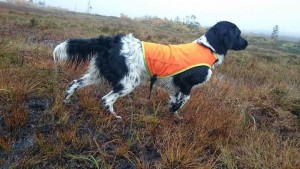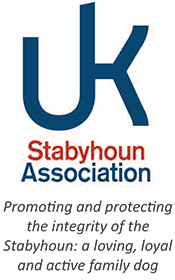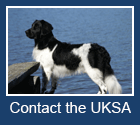In the history of the Stabyhoun we find dogs used successfully as hunting companions, and others living as all-round farm dogs with a knack for catching moles and other vermin. Today, the breed is internationally categorised in FCI Group 7 alongside other pointing dogs such as the Weimaraner, Munsterlander and Italian Spinone. But whether the Stabyhoun does in fact belong here has been a hotly debated topic amongst hunters. Pia Sofie Nilsen from Verdalsøra in Norway regularly writes about her own Stabyhoun’s hunting practice and grouse hunting skills. In this article, she explains why she feels the Stabyhoun does absolutely belong in Group 7, and why the hunting trial system should recognise different styles of hunting dogs instead of focusing on principles that suit just the English breeds…
– I must start by saying that it is not my intention, nor is it that of the Hunting and Working dog Committee of the Norwegian Stabyhoun Club, to make the Stabyhoun a pure pointing dog. Rather, we are working to promote ALL of the breed’s hunting and working skills. The Stabyhoun is an all-rounder, and that will never change.
One of the arguments that comes up often in discussions about the breed’s placement in Group 7 is that they cannot compare with the more traditional pointing dogs. I assume that most are thinking about traditional hunting tests in this context. Unfortunately, hunting tests in Norway are built around the skills and natural abilities of traditional pointing dog breeds. This probably has to do with the fact that hunting with pointing dogs is something we have inherited from England – the country where the most traditional pointing dogs come from such as the Setter. The Englishmen left their dogs here when they were done hunting and travelled back to England. Thereby, these dogs laid the foundation of what we today consider the act of hunting with pointing dogs in Norway.
A flawed hunting system

PIa’s Stabyhoun, Anortositts Rozalina pointing at grouse.
There is nothing wrong with the Stabyhoun; it is the hunting test system and the rules that fail to recognise the different styles of continental breeds. In Sweden, dogs are judged by their own breed standard in hunting tests. This is because no breeds hunt alike and because each breed’s own distinctive hunting style must be preserved. It is unfair to conclude that the Stabyhoun is no good as a hunting dog just because they don’t hunt like a Setter or Pointer. These breeds are not the ultimate blueprint of what makes a good hunting dog.
Some critics describe the pointing and hunting instincts we see in the Stabyhoun as a ‘flaw’ – simply because they don’t see it clearly pronounced in every individual dog. But let’s not forget that this breed has got a strong history as a pointing dog – sharing ancestors with breeds such as the Müsterlander and Drentsche Patrijshond. So even if pointing is not one of the main traits of the breed, it is an important part of its history and versatility. Sadly, I think this sort of criticism is partly to blame for why the natural hunting instincts in the Stabyhoun are in danger of disappearing.
No one right way of hunting
When we look at other Group 7 breeds, we find many different types of hunting and working – not just pointing. The German Shorthaired Pointer, for example, is in addition to being a good gun dog, also is a very popular sled dog. Or the Old Danish Pointer that is described as a dog with great talents in many recreational dog sports. Similarly to the Stabyhoun, this breed also hunts in close proximity to the hunter, has excellent tracking skills, and excels by versatility. Is the Old Danish Pointer then also misplaced in Group 7? I think not.
Even if a breed has other hunting and working skills than what characterises its group, it doesn’t necessarily mean that it is misplaced. We must also not forget that the Stabyhoun is a very rare breed, and therefore selective breeding on hunting skills is not as easy as in the more popular breeds.
To the future
With such a rare breed, selective breeding for hunting skills alone is neither possible nor wise. But I believe that most Stabyhoun have a hunter in them.
Early training and exposure to the trade is essential for the Stabyhoun to reach its full potential. But, in my opinion, those who argue that the Stabyhoun is misplaced in Group 7 are misinformed and perhaps a little narrow minded in how they view the skills of hunting dogs.
I am excited and passionate about promoting the Stabyhoun as a hunting and working dog by encouraging and developing these dogs’ natural talents. And I welcome anyone who is interested in seeing what their dog can do in the field to join us.
Pia Sofie Nilsen
Hunting and Working dog Committee








